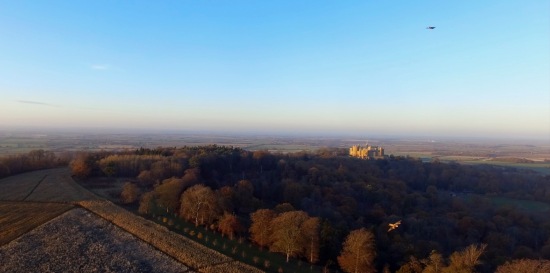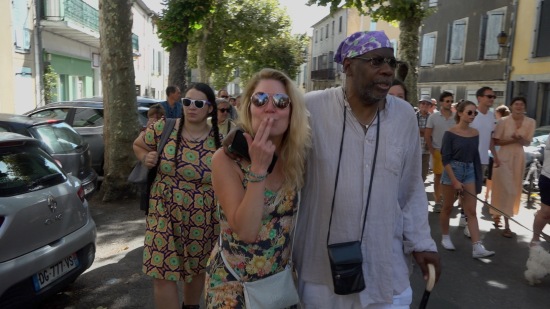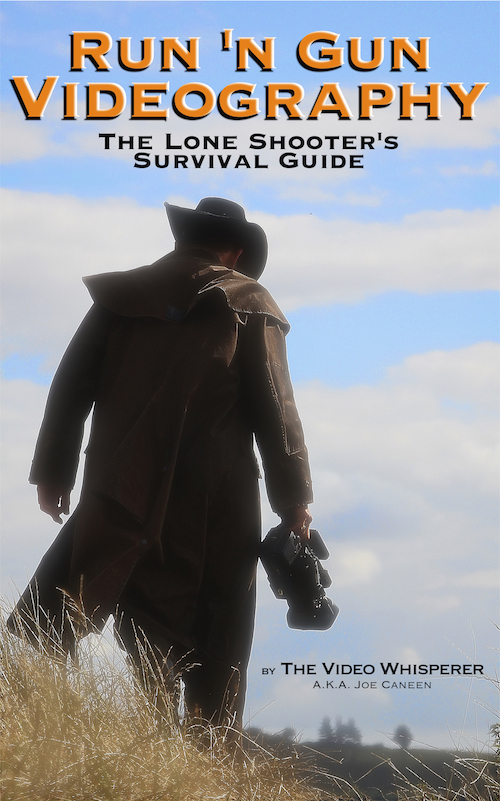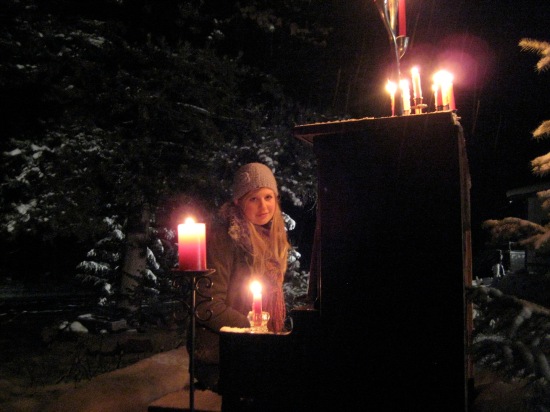For anyone interested who has been following this, I’ve been writing an ebook entitle “Run ‘N Gun Videography–the Sole Shooter’s Survival Guide”.
I’ve now finished the first draft of the book which sits currently at 40,000 words and 25 chapters. I suspect there may be one or two more chapters added, but besides that I’m in editing mode and starting to think about graphics and layout. Should be finally published some time this summer.
Thought I’d share one more sneak preview, this one of Chapter 10. (most of it anyway. Hey! I can’t give away all the punch lines!)
Any feedback would be appreciated.
P.S. For the moment my Video Whisperer website is down for unknown reasons, so you may get an error message if you click that link. I’ve been wanting to re-do the whole thing and move it over to WordPress. Maybe it’s a sign….
Chapter 10, Corporate Shoot-outs
The Video Whisperer Approach to Corporate Videos
I’m using the term “corporate videos” loosely here. I am referring to the full range of business videos likely to be produced by a lone shooter or small production company. In my case, that ranges from home business owners, shop owners, small business owners and on up to multi-national corporations.
Clearly, when you start getting into the big name global corporations, they’re probably not going to be taking you on as a lone shooter.
So we’re not competing here with video production companies that are essentially small film studios with a full complement of specialized personnel.
“Corporate Shootouts” is probably an apt title. The bigger they are, the more people you have to please, the more meetings you have to have, the more planning you have to do and get approved (and modified ‘till everyone’s happy), the more back and forth on your edit, the more unwanted input from executives that want their stamp on your good ideas…and those larger video production companies have people that deal with all of that.
At any rate, I don’t play that game anymore, and if you’re reading this book, you probably don’t play it either. I like to keep it simple.
I travel light.
I don’t go into a corporate shoot like a swat team.
I walk in alone with a 6 shooter.
But I have a strategy.
And the funny thing is, even in that corporate environment I’ve walked into a conference room full of harried scriptwriters and producers and won with this approach, so don’t get the idea that because it’s simple, it can’t be effective.
Are you ready for this?
1) I don’t script it.
2) I don’t storyboard it.
3) I don’t rehearse it.
So far that sounds pretty lame, doesn’t it?
Let me clarify it starting with a little story.
I used to be sent out to various parts of the globe to do a mini documentary on some interesting character by a corporation who had already fully pre-conceived the story and had it scripted by the “very best scriptwriters” based on glowing PR reports from the “very best research personnel”, right on down to the expected content of the interviews and testimonials.
The only trouble was, the real scene on the ground was never what the script said it was. So I used to get beat up about this pretty regularly by the corporate people for “not following the script” because I found real life far more interesting than their imaginary version of it.
One day it dawned on me why it was that the reports sent in to management from the field always understated the actual scene.
The real heroes on the ground that we were sent in to do stories on were too busy (and too humble) to waste much time on paperwork and bragging themselves up to the higher ups. So in the 25th hour of their day, they probably just didn’t spend much time sending their obligatory reports to management.
It was only when I tossed the interview questions and started really chatting these people up that I began to realize that they were too humble to know how extraordinary they really were. They had far more interesting stories to tell than anyone who sent us there knew about.
How ironic. Those “higher ups” were so damned concerned with their own PR that they chose the certainty of false reports based on faulty research over the actual truth which was far more interesting and better PR than they ever dreamed of.
Ok, this is a personal story and won’t have much to do with what most people will run into, but it did teach me a very important lesson that later formed the simplistic approach I started taking toward corporate videos summarized in #1-3 above.
And that lesson was: Real people are far more interesting, sincere and believable than imaginary ones.
I learned this by watching one director interviewing someone in quite a different and remarkable way…
The Secret of Interviews
Let’s face it. We’ve all seen standard, run-of-the-mill TV news interviews.
And we’ve all seen those high-end journalists who make the big bucks because of the compelling stories they supposedly draw out of people.
I’ve seen these things from the back end too. I’ve seen Mike Wallace of 60 Minutes fame (one of those supposed high end investigative journalists) doing a story. He arrived in a limo with a full entourage and large crew. “Intimidating” comes to mind. But this time he left in a big huff with his tail between his legs because the people he was doing a story on decided to run their own 5 cameras on the 60 Minutes interview so that 60 Minutes wouldn’t have the freedom pull off their usual skewed agenda-driven story through the magic of editing. That’s right. You can make people look like fools or criminals or worse just by the way you edit the footage—and I’m afraid that’s probably done more often than not depending on who is financing the story.
Anyway, that’s one extreme. But generally speaking, reporters are after controversy because that’s what sells. They’re after tears on camera and true confessions. They’re after salacious material and confrontations. They either have an agenda or their editors or producers do. That’s the world of journalism for the most part.
Documentaries can also be agenda driven with a similar approach to conducting interviews.
Tell me if I’ve gotten this right:
An interview consists of someone asking a list of prepared questions and getting responses to those questions.
Seems to be a reasonable definition, but it’s about as idiotic as it gets. I wouldn’t even call it simplistic. Not only that, it gets worse.
Typically the interviewer almost never acknowledges the answer before asking the next question. (wouldn’t that make you feel uncomfortable? You’d be wondering, “Did he hear what I just said?”) Worse still: (and I’ve seen this countless times) “that’s great, but could you give that to me again with a smile?” or “great!, but I need you to mention (_________)”, or “don’t bring up (__________)”, or any of an infinite number of other ways to introvert the interviewee because of some stupid pre-conceived idea that the interviewer has in regards to what he thinks the interviewee should say. After a short while the interviewee, convinced that you’re not interested in what they might want to say, spends the rest of the time trying to figure out what you want to hear, and the more he or she apparently “gets it wrong”, the more introverted he or she gets.
If anyone ever asked you a bunch of questions and never once acknowledged anything you’d said, you’d get the idea he wasn’t really very interested in what you had to say and you’d be right. If you had any integrity at all, you’d end the interview and tell the guy to buzz off. But too many people forge on and try to please the interviewer. They cease communicating about their own interests and passions and try to second guess what it is they’re supposed to say to make the interviewer happy.
I don’t care if it’s a news interview or a corporate interview. You get the same results; a dull, lifeless, stilted interview that forwards a supposed news agenda or marketing agenda.
It is so prevalent as a style that too many novice directors fall into the same “reporter mode” because they think that’s the way it’s supposed to be done.
I know I’m generalizing and I know there are exceptions to the rule. There have been truly great and memorable interviews and biographies, but I’m making a point that it is a pretty common approach to corporate videos by small productions companies and lone shooters who “learned it” by watching some of the “big guys”. It probably came about simply because some of these journalists who were on a deadline just didn’t have time to actually talk to someone, or (more likely) had orders from producers to obtain specific content.
A good interviewer puts his or her interviewee at ease and then engages in friendly conversation that makes the person happy and willing to talk. That should be the easy part—like riding a bicycle. The hard part is at the same time steering the interview to the end of obtaining quality, usable material for the purpose intended—like fixing a flat tire. Not very hard really.
The secret to interviews is getting people to talk about what they want to talk about, not what you think they should talk about.
But how to do know what they want to talk about?
You don’t. You just don’t.
It’s no different than meeting someone for the first time.
So you start off with the minimum of what you have in common, even if very little. Well, you’re at their company, right. That’s a start. You’re both aware of the company and what it does. (It goes without saying that you will have done your homework and have some idea of the content or marketing message you are after). Nothing wrong with starting off with “So how long have you been working here?” Easy enough to answer and gets things off on an informal foot. The guy relaxes. He thought you were going to ask a tough question.
And you go on from there finding out about his specialty, his knowledge, his contribution to the company.
Just don’t make the mistake of getting caught up in the brilliance of your own questions. And don’t assume that you know what the ideal response should be, regardless of what the marketing people think.
Your questions are meant to be a good guess at what might get them going and what they want to talk about. And presumably you’re talking to them because they have some intimate knowledge of the subject at hand.
So start chatting. Keep it real. Keep it light and conversational.
And watch their eyes.
When those eyes light up, you’ve just found the entrance to the subject of what they like to talk about, what their passion is, etc. I don’t mean start talking about fishing or motorcycle racing. Obviously he knows what you’re there to talk about that’s relevant. What I’m saying is that when you’re in that area you’re probably going to find a hot spot that lights up his eyes. That’s the subject that’s going to get you some good material. Chat it up from all directions. He may start brief, but due to your interest, he may open up and dump a whole load of great stuff on your lap. It’s your sincere interest that will get him talking.
Listen to what they say. Really listen. Really be interested. Acknowledge what they’re saying by smiling or nodding or whatever is appropriate. Don’t cut them off.
When they seem to be finished, ask them more about what they just said. Better still, ask them something specific about something that they seem particularly interested in or emotive about. You don’t even have to ask a new question. Simply commenting on, agreeing with or otherwise acknowledging some aspect just mentioned will be enough to get them to continue talking about it.
And let them talk.
Of course you also ask all the perfunctory questions. But ideally you first establish a great rapport by talking about their interests. Then all the rest of the stuff will come off great too.
You can talk to anyone about anything that THEY are interested in.
When you find those topics, all their inhibitions disappear–so long as you do your part by listening, acknowledging and not cutting them off.
If it all goes wrong and you can’t seem to get off on the right foot, be humble enough to realize that you’re the one that introverted them and got them to stop talking. There is still an out. I’ve done it many times to miraculous results. It goes something like this:
“Forget about everything I just said or asked. Forget about what you think you should say or what the company thinks you should say or what you think I want to hear. What is it about this subject that interests YOU the most? What about it are you most passionate about? Go ahead, let your hair down.”
Sometimes after 30 minutes of interview, I’ve gotten the greatest percentage of my editable narrative after making that statement alone.
Look at it this way. It’s really simple.
An interview is simply a directed conversation.
But it’s still a conversation.
It’s not formal. It’s relaxed. It’s fun. It’s interesting. It’s something you’ve done naturally all your life.
If you’re shooting a corporate interview or a testimonial, the only difference is that you are a director and you know the sort of content that is required to fulfill the marketing angle (or instructional angle—or whatever kind of video you’re doing). It doesn’t matter how long it takes to accumulate that information. It doesn’t matter a hoot what you say or how much you banter with the interviewee. All that gets cut out. But as you go along you will be making mental notes, “that was a good bit”, or “that’s a great opener”, or “that will work great in the wrap up”, etc.
With experience you’ll know when you have enough material to be able to edit the interview and achieve your objective.
The main point is, that the best of your material in that interview will be honest, sincere, passionate, and believable. But better still, you might well turn up with some great material that no scriptwriter or marketing person could ever have dreamed up for the very best actor or presenter to deliver with all the right hand gestures.
The intended audience for your video can see marketing hype a mile away.
But the real guy, warts and all, speaking from the heart is also something they can see from a mile away. And that’s they guy they’ll listen to.
Ok, that’s a basic overview. I’ll cover some more on this subject later, but for now, let’s get back to what this has to do with shooting corporate videos, or more specifically, how I do it in terms of “the Video Whisperer approach”….






